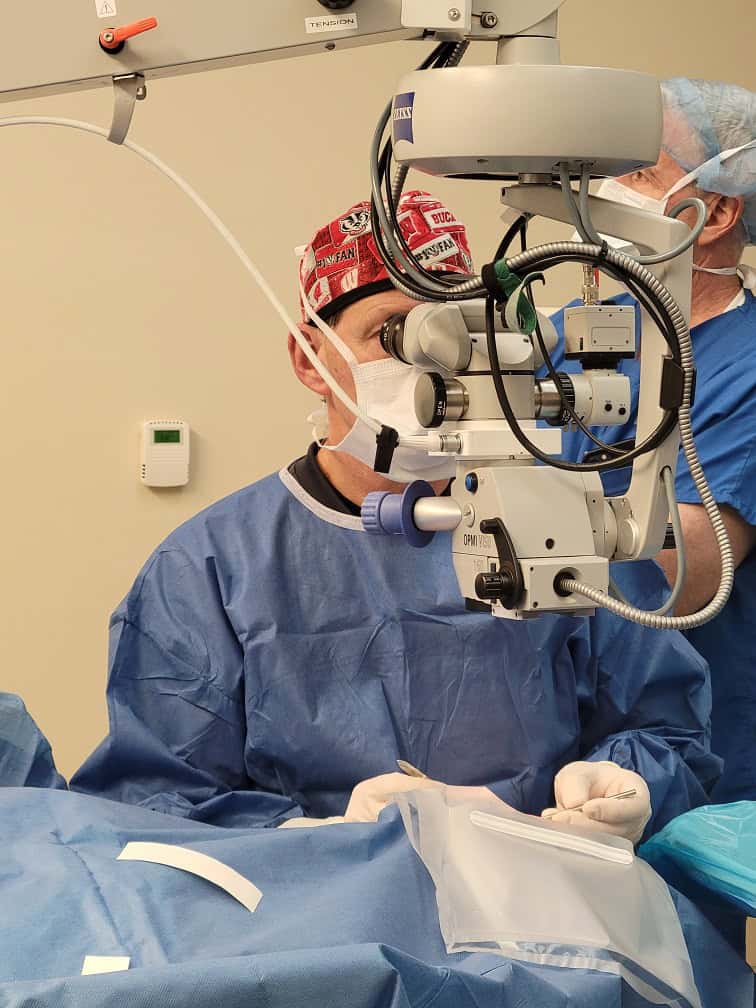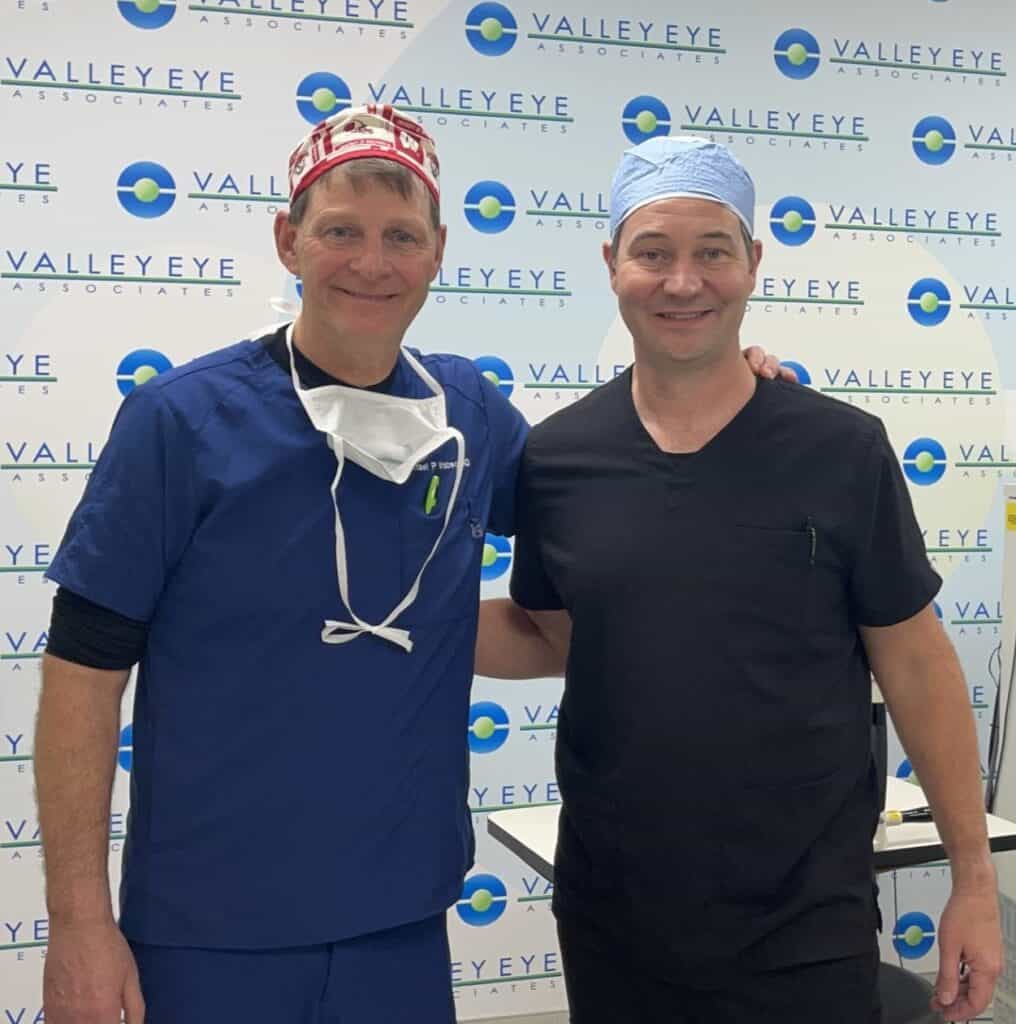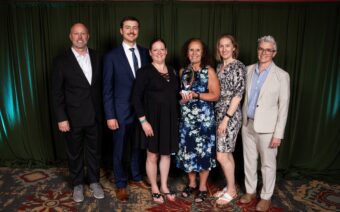
December 2, 2024
APPLETON – In the world of optometry, the future is driven by advancements in technology.
Since 1981, Dr. Michael Vrabec said Valley Eye Associates in Appleton has focused on providing eye-centric health services with the help of state-of-the-art equipment.
Recently, the clinic became the first in the State of Wisconsin to offer an Implantable Collamer Lens procedure, known as EVO ICL.
Vrabec said the procedure is a new vision correction treatment that involves the placement of a lens between the iris and the eyes’ natural crystalline lens.
He said it works similarly to a contact lens to improve vision and can be beneficial for patients who struggle with refractive vision issues like nearsightedness, astigmatism or other progressive eye conditions.
Vrabec, along with fellow Valley Eye surgeon Phil Smith, have undergone extensive, specialized training to offer the procedure.
Both said they credit technology for revolutionizing how patients can manage their eye health and believe the lens will be monumental for individuals who rely on glasses or who were not previously candidates for other vision-enhancing treatments.
“The EVO ICL has been a fantastic addition to our practice, allowing more patients access to improving their sight and their lives,” Vrabec said.
How does EVO ICL work?
Vrabec said the EVO ICL procedure is performed in a sterile surgical suite, typically taking 20-30 minutes per eye.
Patients take a mild sedative before the procedure – but Vrabec said no IV sedation or numbing shots around the eye are needed.
“Multiple tests are performed in the office prior to surgery to make sure the ICL will be well tolerated in the eye and give the patient a good result,” he said.
Vrabec said the procedure entails surgically creating a microscopic opening in the cornea and inserting the lens for ideal placement.
Composed of a material called Collame – a biocompatible collagen co-polymer – Vrabec said the lens contains a small amount of purified collagen, making it soft and similar to the feel of contact lenses.
An ICL procedure, he said, is performed with great precision.
The lens is not visible without using high-grade magnification and does not alter the color of the eye.
Vrabec said the entire process is rather seamless as well, especially since implantation of the lens doesn’t require any invasive procedures beforehand.
Following EVO ICL insertion, Vrabec said patients’ eyes are temporarily covered with a shield or patch, and they are prescribed eye drops to use for several weeks.
After their initial recovery, he said no other maintenance is needed.
Improvements in vision are nearly immediate, and Vrabec said the ICL will remain stable for years.
He said most patients resume normal activities within two to three days of ICL surgery.
The ingenuity behind the lens, Vrabec said, also allows it to provide additional benefits, including protection against UV rays.

“The lens is manufactured to block most UV light that could be harmful to the ocular tissue,” Smith said. “This does not eliminate the need for sunglasses or other protective eyewear, but it does allow for patients to buy those directly over the counter without a doctor’s prescription.”
The procedure itself, Vrabec said, is designed to be permanent, but can be easily reversed – though the need for removal is rare.
“If necessary, the EVO ICL can be removed, and the eye should return to its pre-operative condition,” he said.
A good fit
When exploring options for vision correction, Vrabec said potential candidates should speak with a board-certified ophthalmologist about their unique vision history and any eye conditions or concerns.
Though not everyone is a candidate for every traditional treatment option available, Smith said they may be surprised to learn they do qualify for ICL.
“Many patients may not be candidates for other corneal refractive procedures, such as LASIK or PRK, but could potentially be EVO ICL candidates,” he said.
Smith said an ideal candidate would be a nearsighted individual, with or without astigmatism or someone who is looking for an alternative to glasses and contacts.
Smith said candidates should have had stable eyesight for at least a year before the procedure and have reasonable expectations.
EVO ICL, he said, can correct -3 to -20 diopters of myopia – commonly known as nearsightedness – and up to 4 diopters of astigmatism.
“Even with the placement of EVO ICL, patients who have lost the ability to focus up close, usually age 45 or older, will still require reading glasses for near activities,” he said.
Like any procedure, Smith said ICL does have limitations.
He said it is currently not available to treat hyperopia, known as farsightedness, or presbyopia, the age-related loss of the eye’s ability to focus.
The new LASIK?
As he mentioned previously, Vrabec said patients ineligible for LASIK may be eligible for EVO ICL.
“Unlike LASIK, which removes a small amount of the cornea, the EVO ICL is additive and would have no impact on future cataract surgery that might be needed when the patient enters their golden years,” he said.
Though LASIK treatment can also greatly improve a patient’s eyesight, Vrabec said the procedure is more complex.
“There are limits to the safety and efficacy of LASIK,” he said. “EVO ICL offers the chance for more patients to enjoy the benefits of reduced dependence on glasses and contact lenses.”
In the 15 years he has been performing corneal refractive surgeries, Smith said he has had many patients who have wanted LASIK but for multiple factors, they were not suitable candidates.
“Until EVO ICL, the only way to treat their refractive error was glasses or contacts,” he said. “Now with EVO ICL available, this opens the door for many people wanting to reduce their dependency on glasses or contacts.”
Adding ICL treatment to Valley Eye’s services, Vrabec said, is another way the clinic continues to advocate for its patients’ eye health.
“Our doctors want to provide the most innovative care,” Smith said. “Adding EVO ICL to our offering allows us to treat patients that historically had few options and they now have the ability to see clearly from the time they wake without having to rely on glasses or contacts.”
At this time, Vrabec said EVO ICL is considered elective and is not covered by insurance.
However, patients may still be able to allocate funds toward their procedure through some HSA or FSA plans.
For more information on the EVO ICL procedure, visit valleyeye.com.
Forefront of innovation
Vrabec said this isn’t the first time he has been at the forefront of optometric education and treatment innovation.
He was the first physician in Wisconsin to perform LASIK, ECP Laser treatment, INTACS, high-definition laser cataract surgery, Verisyse implantable contact lens procedures and to utilize a Fugo Plasma blade.
Furthermore, Vrabec said he was the first to operate on laser-assisted cornea transplants in the state and is the first surgeon in Wisconsin to be included in an FDA study on Corneal Collagen Crosslinking – a treatment for Keratoconus, a progressive eye condition in which the cornea bulges outward in a cone shape, resulting in impaired sight.
 Grown Climate Smart, Township 23 Distillery announce partnership
Grown Climate Smart, Township 23 Distillery announce partnership Where food tells a story and farmers are rock stars
Where food tells a story and farmers are rock stars







